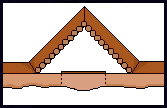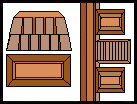
Civil War Field Fortifications
A Glossary of Terms Applied to Civil War Field Fortifications
T - Z
Click on a word to jump to its definition.
| Tambour | Terre-plein | Tete de Pont | Traverse | Trous de Loup | Vertical Fire | |||||||
|
|
|
|||
|
A tambour was a loop-holed stockade with two faces forming a salient angle constructed to defend the gorge of small field works or to guard the doorways of fortified buildings. For another illustration of a tambour see Machicoulis. | ||
| Back to Main Word List |
|
A terre-plein was any level surface inside a fortification. The terre-plein of a field fortification was the interior area enclosed by the foot of the banquette slope and any artillery platforms ramps. In sunken or half-sunken batteries the terre-plain was the area from the foot of the interior slope of the parapet to the slope at the rear of the battery. | ||
| Back to Main Word List |
|
A tete de pont was a field work positioned to cover a bridge. The term was usually applied to works constructed on the hostile side of a river crossing that were intended to provide a safe place of retreat in the event that a field army that crossed the river was defeated and compelled to retire. They were also used to guard bridges once the crossing field army had advanced a distance from the river. | ||
| Back to Main Word List |
 |
A traverse was a steeply sloped rectangular mound of soil usually revetted with gabions that was positioned perpendicular to the crest of the interior slope of a parapet to defilade the banquette. They could also be constructed across the terre-plein to protect against reverse fire. In batteries traverses were positioned between each cannon or every two cannon to protect them from enfilade fire and to limit the destructive effects of explosions within a battery caused by enemy fire or accidents. The height and thickness of traverses were regulated in the same manner as parapets. | ||
| Back to Main Word List |
|
Trous de loup was an obstacle that consisted of a belt of shallow holes about two and one-half feet deep arranged in a quincunx pattern with stakes in the center of each hole. | ||
| Back to Main Word List |
 |
Fire was said to be vertical when it was delivered at a very high angle. Mortars generally used vertical fire to reach their targets. | ||
| Back to Main Word List |
Contents Home Page Major Works Minor Works Siege Works Permanent Fortifications
Copyright (c)PEMcDuffie 1997, 1998